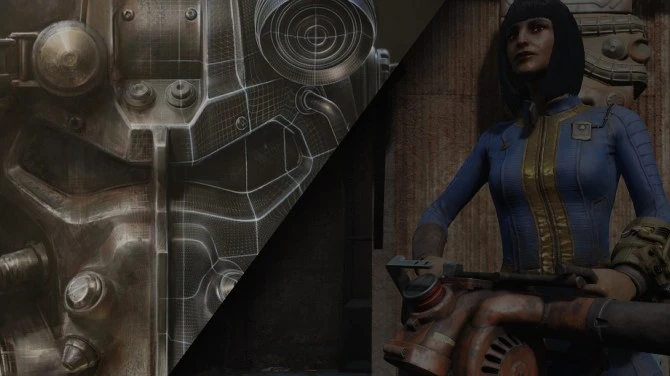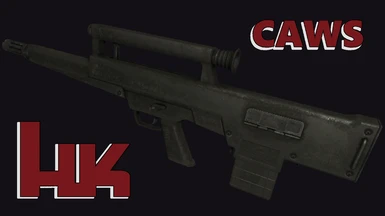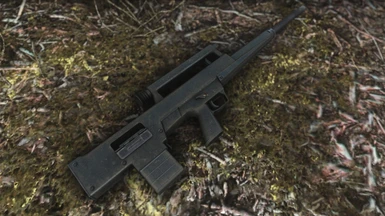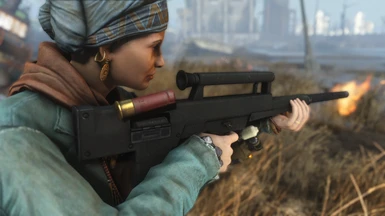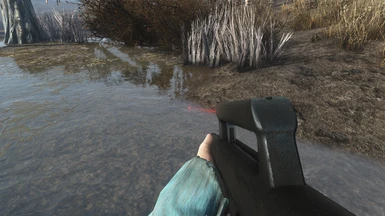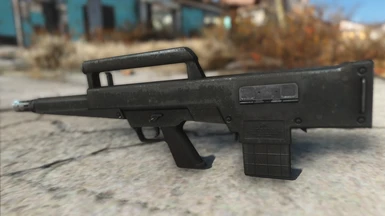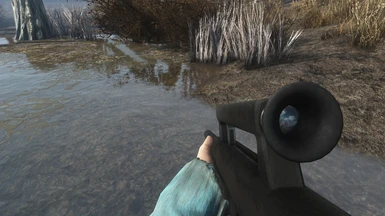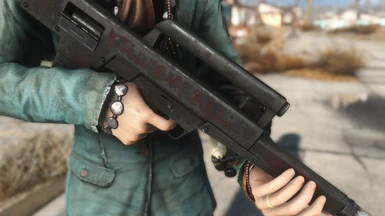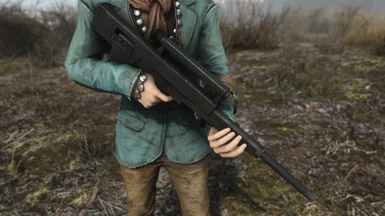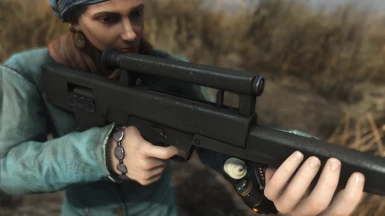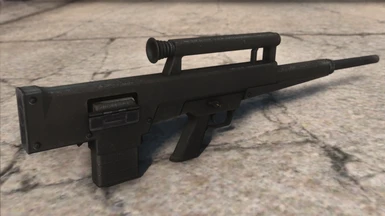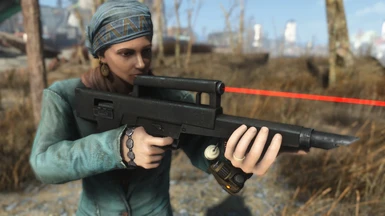About this mod
This mod brings the Heckler & Koch CAWS automatic bullpup shotgun to the commonwealth, with custom meshes, 4K textures, animations, sounds, leveled list integration, and a unique variant.
- Requirements
- Permissions and credits
-
Translations
- Russian
- Mandarin
History
In 1982, the US military launched the Close Assault Weapons System program, which sought to develop a new combat shotgun with much greater range and firepower than the standard-issue Remington 870. The program stemmed from an earlier JSSAP program led by Carroll Childers called RHINO. The military decided to focus on improving soldiers' close-range firepower after experiences in the Vietnam War and the British military's involvement in the Malayan Emergency. Childers' goal was to create a select-fire 12 gauge shotgun with an effective range of up to 150 meters that was faster, more powerful, and easier to control than a conventional shotgun with military buckshot. Childers also stipulated a magazine capacity of 10 rounds, weight of less than 4 kg, armor-piercing projectiles, and a redesigned case that was incompatible with commercial 12 ga. shells, but the guns themselves had to be reverse-compatible with standard buckshot. Several companies submitted shotgun designs to CAWS throughout the 1980s. HK developed the bullpup shotgun seen here, Pancor developed the Jackhammer, AAI developed shotgun based on the M16, and Atchisson submitted the AA-12. Pancor dropped out of the trials due to financial troubles, and HK's entry would eventually win the trials against the other designs. However, the CAWS program was deemed unnecessary and closed at the end of the 1980s, leaving the HK CAWS stuck in the prototype stage.
Mechanism
Ian from Forgotten Weapons has yet to take a look at a CAWS, so I had to dig up all the following info on how it works from primary sources.
The HK CAWS is a gas-assisted, recoil-operated, select-fire bullpup combat shotgun with a recoil-reducing mechanism. It was designed by a team of German engineers led by Helmut Weldle, who also worked on the HK USP, HK P7, HK G36, and HK VP70. The ergonomics were based on the HK G11, which was also in development at the time. The gun was designed in November 1982 and patented on December 4, 1985 (I actually managed to dig up the patent here: https://patents.justia.com/patent/4635530) The patent goes into extreme detail about how the mechanism works, but I will summarize it here:
The action can best be described as a hybrid between long-recoil operation and short-recoil operation, or what I would call a "constant floating recoil" system. The barrel moves backward with the bolt and bolt carrier when the gun is fired, but they are not rigidly locked together for the entire length of travel. Unlike a conventional rotating bolt, the force to unlock it comes from the recoil spring itself, not gas pressure or inertia. The spring tension on the barrel is greater than that on the bolt carrier, and the barrel is slowed by a braking assembly, so initially both pieces move backward together and are locked by spring tension and momentum. However, the bolt is allowed to move backward slightly faster than the barrel, so the bolt unlocks while it and the barrel and moving backward, and eventually the gap increases enough for the casing to eject. There is no rigid stop for the barrel or bolt, instead they are slowed gradually by springs. The bolt assembly, once it has reversed direction, picks up a new cartridge and feeds it into the chamber, at which point both lock back together and return to battery. The system requires a precise amount of applied recoil force to balance out the spring tensions, so Weldle designed a self-regulating gas system to push the mechanism backward if lower-powered shells are used. There is a gas port several inches down the barrel which vents gas into a tube, where the gas pressure pushes backward on the gas piston. There is a shut-off valve around the barrel, so the gas port only vents into the tube if the barrel has not moved a set distance before the projectile clears the port, so heavier-recoiling rounds will not vent gas into the tube but lighter rounds will.
All in all, this serves to evenly spread out the recoil forces over the entire cycle of firing, so the shooter feels a gradual push rather than a sudden kick. The only downside is the extra complexity of the gas regulator and the foot or so of space needed for the recoiling mechanism, but the bullpup configuration conserves enough space to make it relatively light and compact even with the 27-inch barrel extension.
Whew, that was alot of info to get from an obtusely worded German patent... I have a headache now. I hope Ian gets his hands on one soon so he can explain it, he'd probably do a better job than me LOL.
Effectiveness
The ammunition for the CAWS was developed as a cooperative project with Winchester/Olin. Winchester came up with a 3" brass belted magnum 12 ga. shotgun shell which could not chamber in a regular shotgun due to the belt, but regular shells could chamber and fire in the CAWS. The shells were officially designated caliber 18.5x76mmR. The standard load was 8 pellets of 000 buckshot (total weight of 36 grams or 1.3 oz) at 1600 feet per second, much stronger compared to the military standard buckshot which was 9 pellets of 00 buck (total weight of 31 grams or 1.1 oz) at 1300 feet per second. In addition, armor-penetrating ammunition was developed to meet the program's specifications. Tungsten buckshot and steel flechettes were developed, though the flechettes had stability and accuracy issues and were eventually dropped. The gun could be fitted with a variety of chokes and muzzle devices to increase accuracy and power, such as a barrel extension which brought the barrel out from 18" to 27" and greatly improved power with the hotter magnum shells. The muzzle attachments were affixed to a stationary bushing around the muzzle so the barrel could reciprocate independently. Some early prototypes appeared to have been fitted with integral suppressors, but I haven't found any written documentation to back that up.
Lore
The HK CAWS appeared in two earlier Fallout games, Fallout 2 and Fallout Tactics. In those games it appeared to be a rare but still obtainable weapon despite never having left the prototype stage IRL, so it must have seen at least some production in the Fallout Universe. In both games, it is a step above the combat shotgun but less powerful than the Jackhammer, even though the Jackhammer would likely be less powerful in the real world. So, I made it similar in power to my Jackhammer mod.
- Custom mesh
- Custom 4K textures
- Custom 1st and 3rd person animations
- Custom sounds
- Custom load screen
- Leveled list integration
- 7 receivers, 12 ammo types, 7 sights, 2 magazines, 6 muzzles, and 2 fire modes.
- Unique variant: "Kill 'Em All", with explosive and rapid legendary effects.
I tried to balance the gun as much as possible, but it's hard to balance a fully automatic shotgun specifically designed to outclass everything else. It's miles ahead of the vanilla combat shotgun, but it's really hard to find and expensive, and is limited to a 10-round magazine.
- Base damage: 83 (semi auto) 73 (full auto)
- Base DPS: 249 (semi auto) 329 (full auto)
- Base critical multiplier: 2x
- AP cost per burst: 30 (single) 45 (burst)
- Magazine capacity: 10
- Base range: 71
- Base accuracy: 50
- Base weight: 8.5 lbs
- Base value: 2750 caps
- Base reload time: 3 seconds
- Base bash damage: 6
- Out-of-range multiplier: 0.5x
The gun is added into the leveled lists and will start appearing on high-level gunners and vendors at level 30. The unique variant, Kill 'Em All, is hidden somewhere in the wasteland. If you know a thing or two about *ahem* metal and know about some of the game locations and are good at puzzles and word games, then you should be able to work out the location. I'll give you 4 hints.
Hint 1: track 4.
Hint 2: what does a female have that a male doesn't?
Hint 3: number 26
Hint 4: hint 2 and hint 3 are the same thing
If you can't figure it out and wanna cheat, here's the location
:The unique variant is completely overpowered and is basically just a fun addition. If you're familiar with Fallout 76 legacy weapons it's pretty much that on steroids.
Sounds by Navaro
Tools used: Blender 2.49b, 3ds Max 2015, NifSkope, GIMP 2.10, Bethesda Creation Kit, Maik's F4Biped Animation Rig, and the Leveled List Injection Toolbox by a_blind_man.






